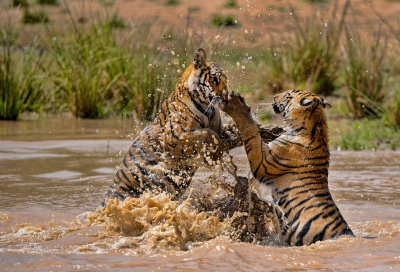
Covering more than 1,000 sq.km through the districts of Umaria and Katni in Madhya Pradesh, Bandhavgarh Tiger Reserve was the hunting grounds of the erstwhile Maharaja of Rewa. It was a national park before it was brought under Project Tiger. A region with a high density of the royal, Bengal tiger, it makes for a balanced ecosystem with a good number of well-distributed herbivores. Hills, valleys, rivers, marshes and meadows dominate the region that supports a large variety of flora and fauna. Located in the Vindhya mountain range, it nurtures more than 30 species of mammals, 250 species of birds and 70 species of butterflies.
Wildlife
Pochards, geese, francolins, quails, nightjars, swifts, malkohas, bitterns, herons, egrets, ibises, thickness, plovers, lapwings, jacanas, sandpipers, redshanks, terns, buzzards, hornbills, beeeaters, parakeets, minivets, cuckooshrikes, woodshrikes, leafbirds, munias, pipits, buntings, larks, wagtails, prinias, warblers, strarlings, flycatchers, thrushes and bushchats are among the many species of birds that can be found here. The animals of Bandhavgarh include tigers, leopards, wild dogs, wild cats, gaurs, bears, hyenas, foxes, wolves, chitals, sambar, barking deer, blue bulls, and blackbuck.
Newcomers and new concerns
Madhya Pradesh has traditionally been a tiger country. However, newcomers from another species have gained a lot of attention – elephants. And for all the wrong reasons. In 2018, a herd of 40 elephants is said to have moved to the State from neighbouring Chhattisgarh. Today the group is active in and around three national parks of the State, including Bandhavgarh. A few villages near Bandhavgarh have been witnessing human-animal conflict because these elephants raid the crops in the villages and barge into houses, helping themselves to stored grains. In the process, elephants have even injured a few villagers. About 50 villages have been impacted by the elephant movement, according to forest officials. To avoid human-elephant by the elephant conflict, the animals are being tracked and have been fed too. Forest officials say deforestation and habitat degradation could be pushing elephants out of their original habitats into others, often resulting in such conflict.
Tourism at what cost?
In 2019, Madhya Pradesh was declared the “tiger State” of India with 526 big cats, the highest number for any state. Shortly after this came the news that the government had “decided to build helipads would be used for helicopters ferrying tourists.) The government felt that such a status should be put to good economic use for helping the tourism industry. However, several wildlife experts and conservationists argued that critical wildlife habitats “should not be disturbed” and that tiger reserves were meant to protect the animal not tourism. Anything that violates the guidelines to protect reserves will effect not just the apex predator but also several others. Since the government that proposed the construction of helipads fell and a new government has come to power the present status of the proposal is not very clear.
Picture Credit : Google




